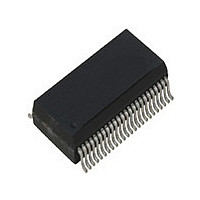ICS1893BF IDT, Integrated Device Technology Inc, ICS1893BF Datasheet - Page 60

ICS1893BF
Manufacturer Part Number
ICS1893BF
Description
PHYCEIVER LOW PWR 3.3V 48-SSOP
Manufacturer
IDT, Integrated Device Technology Inc
Series
PHYceiver™r
Type
PHY Transceiverr
Specifications of ICS1893BF
Protocol
MII
Voltage - Supply
3.14 V ~ 3.47 V
Mounting Type
Surface Mount
Package / Case
48-SSOP
Lead Free Status / RoHS Status
Contains lead / RoHS non-compliant
Number Of Drivers/receivers
-
Lead Free Status / Rohs Status
Not Compliant
Other names
1893BF
Available stocks
Company
Part Number
Manufacturer
Quantity
Price
Part Number:
ICS1893BF
Manufacturer:
ICS
Quantity:
20 000
Company:
Part Number:
ICS1893BFI
Manufacturer:
OKI
Quantity:
1 934
Part Number:
ICS1893BFILF
Manufacturer:
ICS
Quantity:
20 000
Company:
Part Number:
ICS1893BFLF
Manufacturer:
ICS
Quantity:
409
Part Number:
ICS1893BFLF
Manufacturer:
ICS
Quantity:
20 000
Part Number:
ICS1893BFLFT
Manufacturer:
IDT
Quantity:
20 000
7.3.9 Remote Fault (bit 1.4)
7.3.10 Auto-Negotiation Ability (bit 1.3)
7.3.11 Link Status (bit 1.2)
ICS1893BF, Rev. F, 5/13/10
An STA reads bit 1.4 to determine if a Remote Fault exists. The ICS1893BF sets bit 1.4 based on the
Remote Fault bit received from its remote link partner. The ICS1893BF receives the Remote Fault bit as
part of the Link Code Word exchanged during the auto-negotiation process. If the ICS1893BF receives a
Link Code Word from its remote link partner and the Remote Fault bit is set to:
•
•
Bit 1.4 is a latching high status bit. (For more information on latching high and latching low bits, see
7.1.4.1, “Latching High Bits”
Note:
The STA reads bit 1.3 to determine if the ICS1893BF can support the auto-negotiation process. If the
ICS1893BF:
•
•
The purpose of this bit 1.2 (which is also accessible through the QuickPoll Detailed Status Register, bit
17.0) is to determine if an established link is dropped, even momentarily. To indicate a link that is:
•
•
This bit is a latching low (LL) bit that the Link Monitor function controls. (For more information on latching
high and latching low bits, see
Bits”.) The Link Monitor function continually observes the data received by either its 10Base-T or
100Base-TX Twisted-Pair Receivers to determine the link status and stores the results in the Link Status
bit.
The criterion the Link Monitor uses to determine if a link is valid or invalid depends on the following:
•
•
•
•
For more information on the Link Monitor Function (relative to the Link Status bit), see
“10Base-T Operation: Link
Zero, then the ICS1893BF sets bit 1.4 to logic zero.
One, then the ICS1893BF sets bit 1.4 to logic one. In this case, the remote link partner is reporting the
detection of a fault, which typically occurs when the remote link partner is having a problem with its
receive channel.
Cannot support the auto-negotiation process, it clears bit 1.3 to logic zero.
Can support the auto-negotiation process, it sets bit 1.3 to logic one. (For the ICS1893BF, the default
value of bit 1.3 is logic one.)
Valid, the ICS1893BF sets bit 1.2 to logic one.
Invalid, the ICS1893BF clears bit 1.2 to logic zero.
Type of link
Present link state (valid or invalid)
Presence of any link errors
Auto-negotiation process
ICS1893BF Data Sheet - Release
The ICS1893BF has two versions of the Remote Fault bit.
•
•
The operation of both bit 1.4/17.1 and bit 5.13 are in compliance with the IEEE Std 802.3u.
One version of the Remote Fault bit is a latching high version. An STA can access this version
through either Management Register 1 (bit 1.4) or 17 (bit 17.1). This bit 1.4/17.1 is cleared when
an STA reads either of these registers. (Bit 1.4 is identical to bit 17.1 in that they are the same
internal bit.)
Another version of the Remote Fault bit is updated whenever the ICS1893BF receives a new
Link Control Word. An STA can access this version through Management Register 5 (bit 5.13),
which like bits 1.4/17.1, also reports the status of the Remote Fault bit received from the remote
link partner. However, bit 5.13 is not a latching high bit.
Monitor”.
and
Section 7.1.4.1, “Latching High Bits”
Section 7.1.4.2, “Latching Low
Copyright © 2009, IDT, Inc.
All rights reserved.
60
Bits”.)
and
Chapter 7 Management Register Set
Section 7.1.4.2, “Latching Low
Section 6.5.5,
May, 2010
Section
















